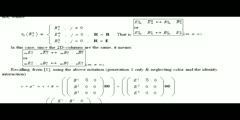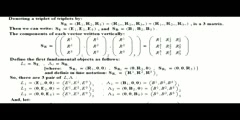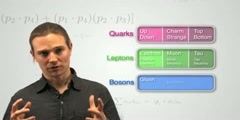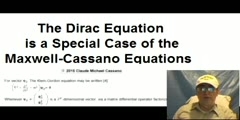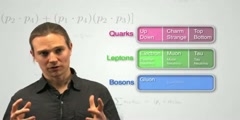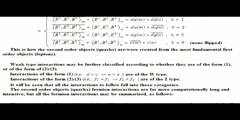Hadron Architecture and Meson Decays 2
Hadron Architecture and Meson Decays 2 © 2011 Claude Michael Cassano A look at a 3-depth column-wise configuration of protons and neutrons reveals why the solitary proton is stable and the neutron is not. All baryons are of the following form (through depth/generation). In the 1st class, there are EEE's through depth/generation. Thus, two are electric field bound to the same one, as well as color bound. In the 2nd class, two are separately electric field EE bound through depth/generation, as well as color bound. In the 3rd & 4th classes, there is no electric field binding through depth/generation. Only color binding is in effect. Thus, the 1st class is the most stable, followed by the 2nd class. And, so, as the lightest rest mass baryon of the first class, the proton is the most stable. And this extra binding is why A+B→C+D => C-bar + D-bar → A-bar + B-bar is not satisfied by all baryons. Nucleon binding like the interaction, here, is another classic illustration of a basic nucleon interaction. Leptons are symmetric, each dimensional component is of the same type. So are photons. But quarks are mixtures, gushing and surging, contracting, and billowing and bulging about along it's streaming course - the orthogonal electric and magnetic field components acting on each other as they travel. Higher energy quarks gush about more. When quarks are bound to one another, this is manifested as binding energy, measured as the hadron rest mass. When a bulge of a u of a nucleon encounters a bulge of a d of another nucleon, as a pair each undergoes an opposing light fermion interaction. This wave-bulge encounter resembles the transfer of a zero spin particle. Clearly, these bulges are not sufficiently expressed by a nucleon for binding to another unless it's energy is at least the rest mass of the nucleon plus that of a pi-meson. The binding energy of a nucleon pair seems to be the minimum energy required to maintain a bulging rate of both nucleons to maintain these opposing light fermion interactions at a sufficient rate that once joined the nucleons do not separate. The decay process of all hadrons is in a similar manner into another set of lighter hadrons and some combination of mesons, and light fermions (leptons and quarks/first and second order objects). As an example, the decay process of a baryon is is always to another lighter baryon and some combination of mesons, light fermions and photons. Remembering that lepton pair are omitted in the schematics and quark mesonic pair may rearrange in depth, these are in agreement with observed meson decay modes; of which, examples from [7] & [8] are shown. Now, one may ask, how does a hadron (meson or baryon) with rest mass less than the W/Z energy decay in the same manner as the light fermion interaction? Or even the above nucleon interaction? Leptons do not decay, only hadrons - i.e. quark systems. When the E/B wave bulges of a quark in an S sub R matrix are disturbed sufficiently by a nearby quark (even in the same S sub R matrix), the system becomes unstable and decay proceeds via light fermion interaction - despite the lack of an energy level of W/Z . Thus, the W/Z energy level/region are level sufficient (but not necessary) to disturb an E/B object wave system enough to force a light fermion interaction, not a requirement for such an interaction. Note that this also explains how the nucleon interaction occurs despite the existence of a W/Z energy level. Photons do not interact directly with second order objects. Photons do not add energy to a first order object, or second order object of any multiple (singleton (quark), pair (meson), triplet (hadron)) - making them spin faster and farther apart, so splitting into another quark pair. No, the only thing that can happen is interactions. A collision of a hadron with a photon may involve an interaction. The occurrance of a photon self-interaction may produce a matter/anti-matter pair going into the interaction region possibly resulting in light fermion interaction chains. The reason that individual quarks are not observed in the interaction region, is that they are fused in an S sub R matrix. Again, as noted above, the S sub R matrix is observed as a single particle, not as a combination of separate particles, so the quarks are not observed while within the fused S sub R matrix state. Further, as noted above, mesons (and the other hadrons) are complete S sub R matrices, so each is also observed as a single particle As an example, consider a photon meson interaction, as follows. γ+π-plus=γ+u-sub-R:d-sub-G-bar →e-plus:e-minus+u-sub-R:d-sub-G-bar=e(1)-bar:e(1)+u-sub-1(1):d-sub-2(1)-bar From the interaction table [1], the possible interactions are shown, here: Since all type of first order objects (fermions) may be manifested from these interaction resultants, a further interaction chain may occur (as part of this overall interaction or separate from it) which covers the entire range of all light fermion interactions. Thus, the S sub R matrix structure has gone beyond the standard model particle arrangement, into the hadronic arrangement and decay characteristics. Note that this result of [1] does not require gluons for decay processes and nucleon binding. Spin 1 gluons are necessary, because in current theory light fermion interactions only take place via W and Z particles, which are of far higher energy than nucleons and most hadrons - which would thus, violate energy conservation (on a massive scale!). Just as the meson decay processes have been schematically represented above, all hadron decay and interaction processes may be similarly schematically represented. This will illustrate how individual quarks are never in isolation, thus explaining what has been termed quark "confinement". The illuminatti would have you believe string/membrane theory is at the foundation of the standard model and all else, but string and menbrane theory are Hamilton's principle applied to vibrating strings/membranes possibly tacked down at certain points. But, in [1] it is shown that Hamilton's principle is a mathematically derived consequence of the chosen algebra. As an aside, this also demonstrates that Hamilton's principle need not be true in spaces with different algebras. Therefore, taking Hamilton's principle as a fundamental is a most certainly questionable step, and if it is found sound, that is because it is a consequence of the underlying architecture of the space (as shown, in [1]). Just as Galileo and the ideas of Copernicus were condemned and censored in the sixteenth and seventeenth cetuuries by Vatican syncophants, especially Jesuits; so it is, today. One may not obtain a phD or publish in a peer-reviewed journal unless meeting the criteria of the overarching brotherhood. The enlightenment of truth is cloaked by their Illumination. You can lie to gravity, but you still fall off a cliff - the lie means nothing to it. Similarly, gravity does not lie, you know how it treats everyone - rich and poor alike. Mathematics is the same way. Experts, and those of high renown and high reputation, on the other hand, are not only experts in their fields, but expert liars as well. So beware of them and their interpretations. Prove all things; hold fast that which is good./nFind links to all my books at the site listed at the bottom, here: /nhttps://sites.google.com/site/themathematicalnatureofreality/config/pagetemplates/books
Channels: Physics (General) Particle physics
Tags: standard model Klein-Gordon Dirac Equation electric magnetic field hadron meson baryon particle physics
Uploaded by: cloudmichael ( Send Message ) on 02-11-2011.
Duration: 16m 16s
